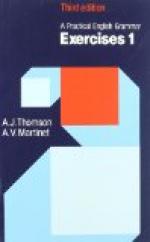1. Arrange the following words in two columns,
putting in the first column
words that are in good use, in the
second, words that are not in good
use. Consult Hill’s “Foundations
of Rhetoric,” pp. 27-29: Omnibus,
succotash, welkin, ere, nA(C)e,
depA’t, veto, function (in the sense of
social entertainment), to pan out,
twain, on the docket, kine,
gerrymander, carven, caucus, steed,
to coast (on sled or bicycle),
posted (informed), to watch out,
right (very).
2. Give good English equivalents for the words
which are not in good use.
CHAPTER II.
OF ARTICLES
A or AN.[7]—The choice between these forms is determined by sound, not by spelling. Before a consonant sound “a” is used; before a vowel sound “an” is used.
[7] “Foundations,” pp. 32-36.
EXERCISE IV.
Put the proper form, “a” or “an,” before each of these expressions:—Elephant, apple, egg, union of states, uniform, uninformed person, universal custom, umpire, Unitarian church, anthem, unfortunate man, united people, American, European, Englishman, one, high hill, horse, honorable career, hypocrite, humble spirit, honest boy, hypothesis, history, historical sketch, heir, hundred, hereditary disease, household.
THE or A.[8]—“The” is a broken-down form of the old English thoet, from which we also get “that,” and is used to point out some particular person, thing, or class: as, “The headmaster of the school gave the boys permission.” When “the” is used before the name of a particular class of persons or things it is called the “generic” article (from genus, “a class"): as, “None but the brave deserve the fair”; “The eagle is our national bird.”
“An” ("a”) is a broken-down form of the old English word ane, meaning “one.” It is properly used when the object is thought of as one of a class: as, “There is an eagle in the zoological garden.” It cannot properly be used before a word which is used as a class name, because a class name includes in its meaning more than “one.”
SUPERFLUOUS and OMITTED ARTICLES.[9]—The use of a superfluous “a” or “an” before a class name, especially after the words “sort” and “kind,” is a common and obstinate error. We may say, “This is an eagle,” meaning “one eagle.” But we may not say, “An eagle is our national bird,” “This is a rare kind of an eagle,” or, “It is not worthy of the name of an eagle”; because in these sentences “eagle” is used as the name, not of a single bird, but of a class of birds, and includes in its meaning all the birds which belong to the class called “eagle.” The sentences are equivalent to: “The kind of bird called ‘eagle’ is our national bird;” “This is a rare species of the class of birds called ‘eagle;’” “It is not worthy of the name given to the birds which belong to the class called ‘eagle.’”




